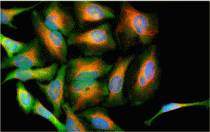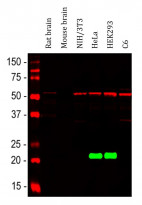ARG52388
anti-PARK7 / DJ1 antibody [4H4]
anti-PARK7 / DJ1 antibody [4H4] for ICC/IF,Western blot and Human,Bovine
Cancer antibody; Gene Regulation antibody; Metabolism antibody; Neuroscience antibody; Signaling Transduction antibody
Overview
| Product Description | Mouse Monoclonal antibody [4H4] recognizes PARK7 / DJ1 |
|---|---|
| Tested Reactivity | Hu, Bov |
| Species Does Not React With | Ms, Rat |
| Tested Application | ICC/IF, WB |
| Host | Mouse |
| Clonality | Monoclonal |
| Clone | 4H4 |
| Isotype | IgG1 |
| Target Name | PARK7 / DJ1 |
| Antigen Species | Human |
| Immunogen | Full length recombinant human PARK7 / DJ-1 expressed in and purified from E. coli |
| Conjugation | Un-conjugated |
| Alternate Names | DJ1; DJ-1; Oncogene DJ1; EC 3.5.1.-; Parkinson disease protein 7; HEL-S-67p; EC 3.1.2.-; Protein deglycase DJ-1 |
Application Instructions
| Application Suggestion |
|
||||||
|---|---|---|---|---|---|---|---|
| Application Note | Specific for the ~21k park7 protein. * The dilutions indicate recommended starting dilutions and the optimal dilutions or concentrations should be determined by the scientist. |
Properties
| Form | Liquid |
|---|---|
| Purification | Affinity Purified |
| Buffer | PBS and 10 mM Sodium azide |
| Preservative | 10 mM Sodium azide |
| Storage Instruction | For continuous use, store undiluted antibody at 2-8°C for up to a week. For long-term storage, aliquot and store at -20°C or below. Storage in frost free freezers is not recommended. Avoid repeated freeze/thaw cycles. Suggest spin the vial prior to opening. The antibody solution should be gently mixed before use. |
| Note | For laboratory research only, not for drug, diagnostic or other use. |
Bioinformation
| Database Links | |
|---|---|
| Gene Symbol | PARK7 |
| Gene Full Name | parkinson protein 7 |
| Background | Park7, also known as DJ-1, is a member of the peptidase C56 family of proteins and is thought to function as a molecular chaperone. Mutations in park7 have been associated with autosomal recessive, early onset Parkinson’s disease (Bonifati et al., 2003). Recently, park7 has been shown to inhibit microtubule associated protein 1B aggregation thus leading to neuronal apoptosis (Wang et al., 2011). |
| Highlight | Related products: PARK7 antibodies; Anti-Mouse IgG secondary antibodies; Related news: Astrocyte-to-neuron conversion for Parkinson's disease treatment |
| Research Area | Cancer antibody; Gene Regulation antibody; Metabolism antibody; Neuroscience antibody; Signaling Transduction antibody |
| Calculated MW | 20 kDa |
| PTM | Sumoylated on Lys-130 by PIAS2 or PIAS4; which is enhanced after ultraviolet irradiation and essential for cell-growth promoting activity and transforming activity. Cys-106 is easily oxidized to sulfinic acid. Undergoes cleavage of a C-terminal peptide and subsequent activation of protease activity in response to oxidative stress. |
Images (2) Click the Picture to Zoom In
-
ARG52388 anti-PARK7 / DJ1 antibody [4H4] ICC/IF image
Immunofluorescence: HeLa cells stained with ARG52388 anti-PARK7 / DJ1 antibody [4H4] (green) showing strong cytoplasmic staining and ARG52468 anti-Vimentin antibody (red).
-
ARG52388 anti-PARK7 / DJ1 antibody [4H4] WB image
Western blot: Rat brain, Mouse brain, NIH/3T3, HeLa, HEK293 and C6 cell lysates stained with ARG52388 anti-PARK7 / DJ1 antibody [4H4] (green) at 1:5000 dilution. The blot was simultaneously stained with ARG52468 anti-Vimentin antibody (red) at 1:5000 dilution.
Clone 4H4 detects protein with apparent molecular weight of 21 kDa but only in Human cell lines, since it does not recognize the Mouse or Rat DJ1 protein.







